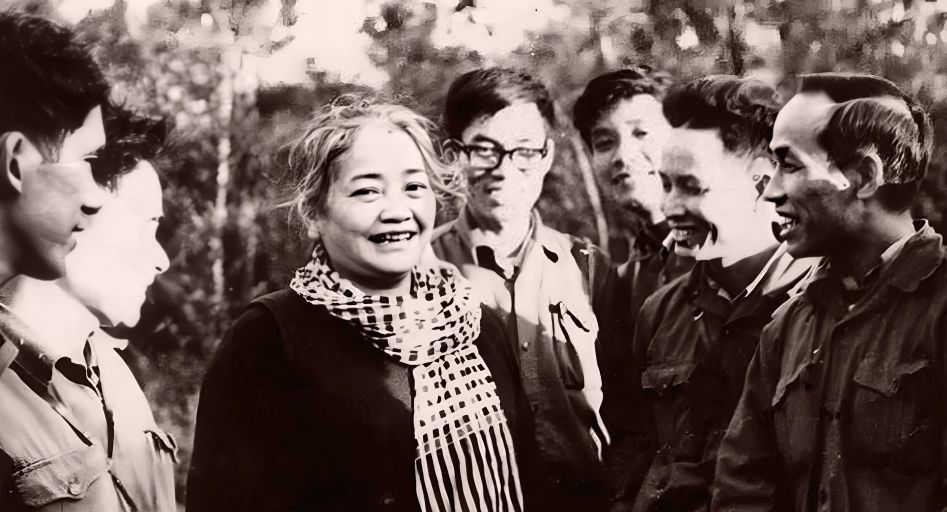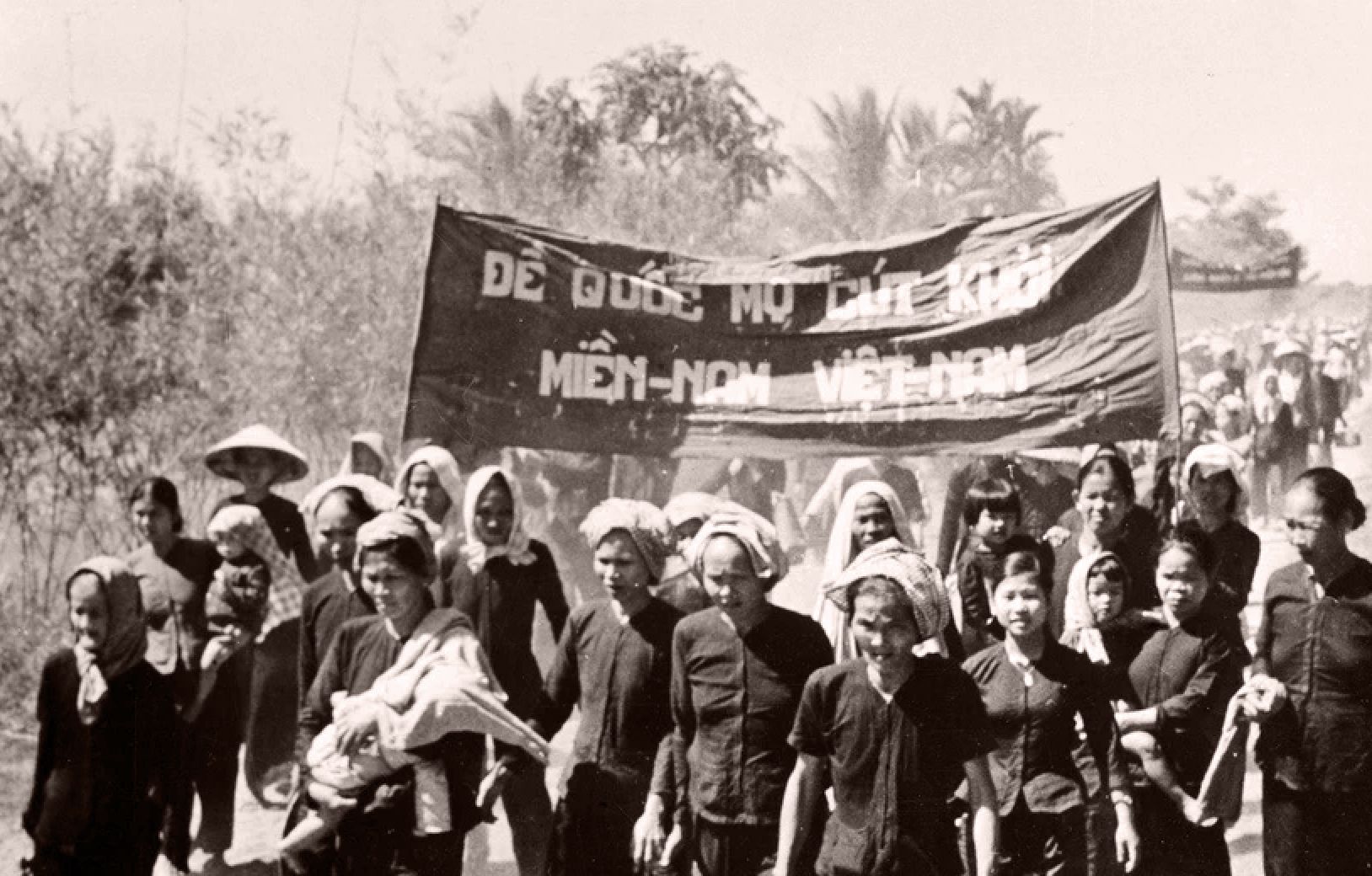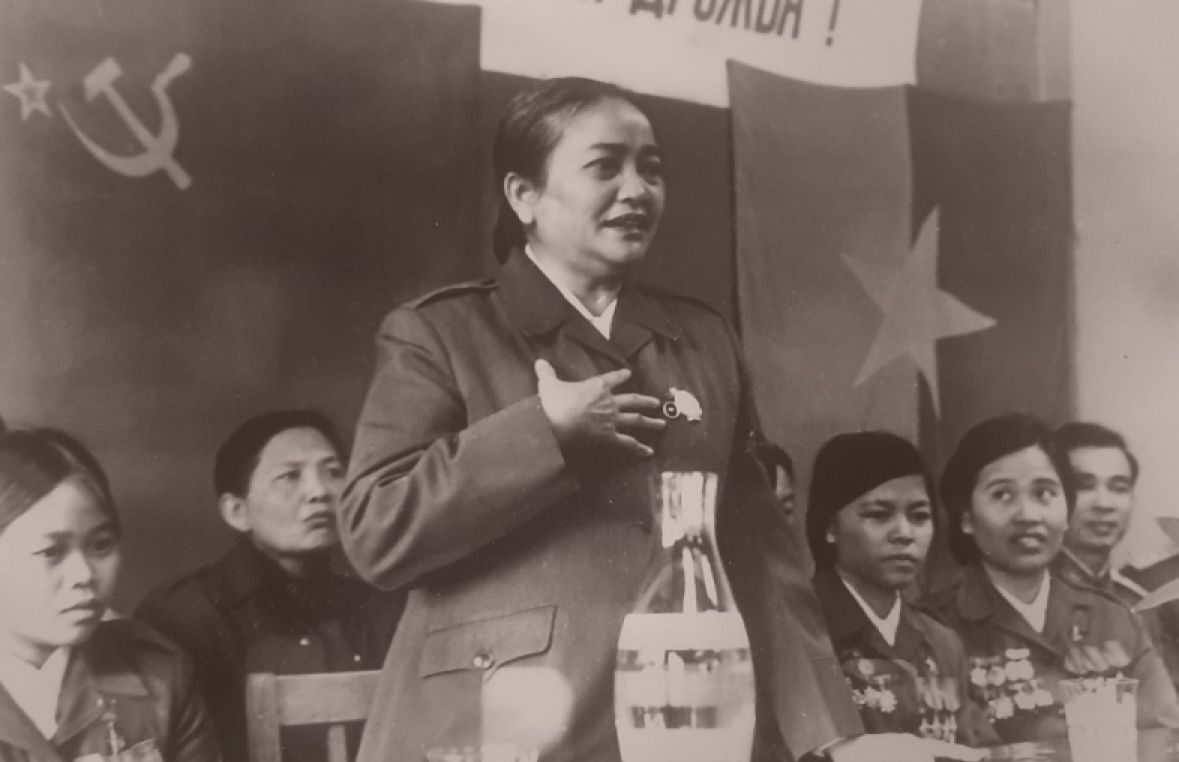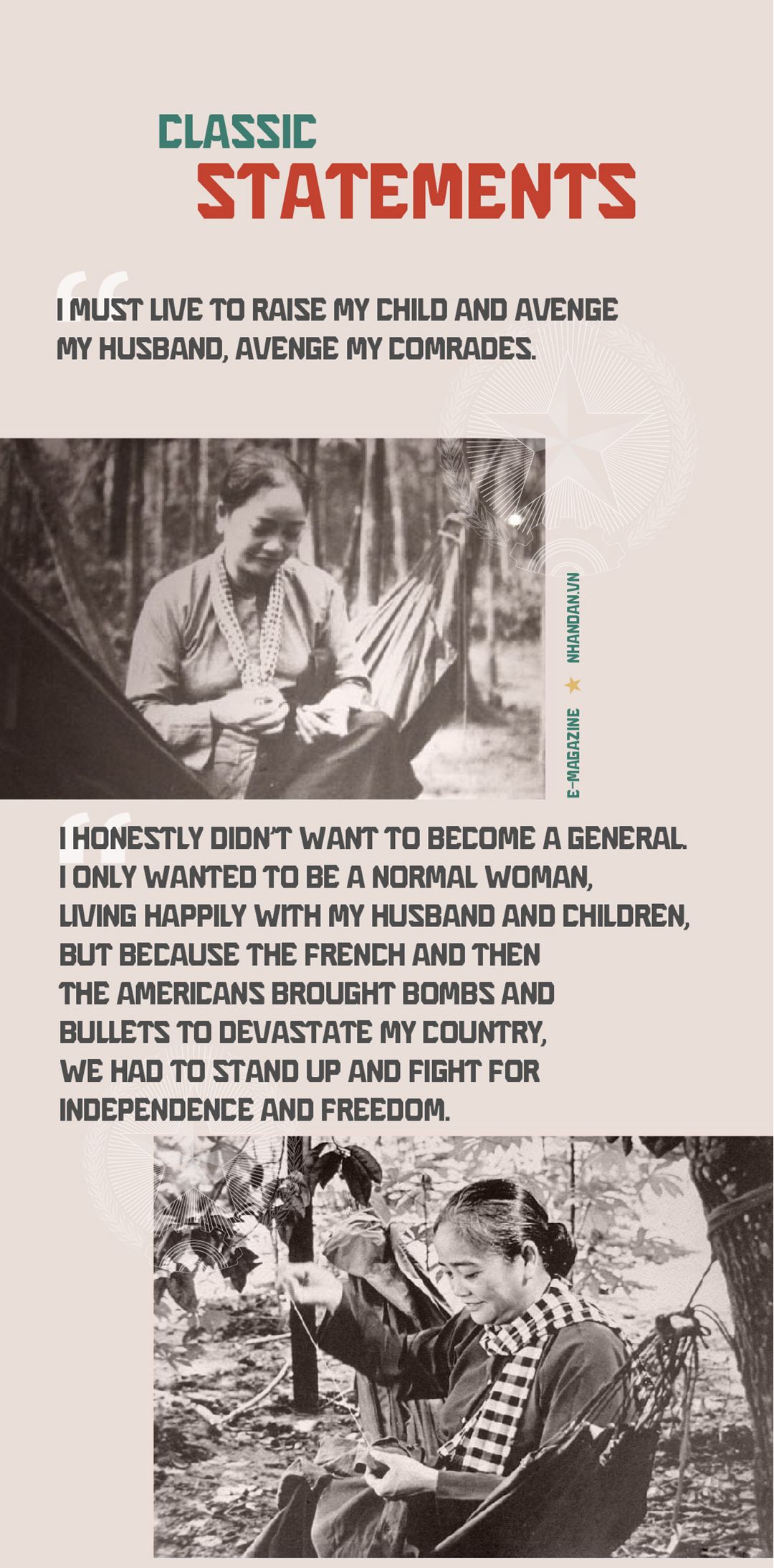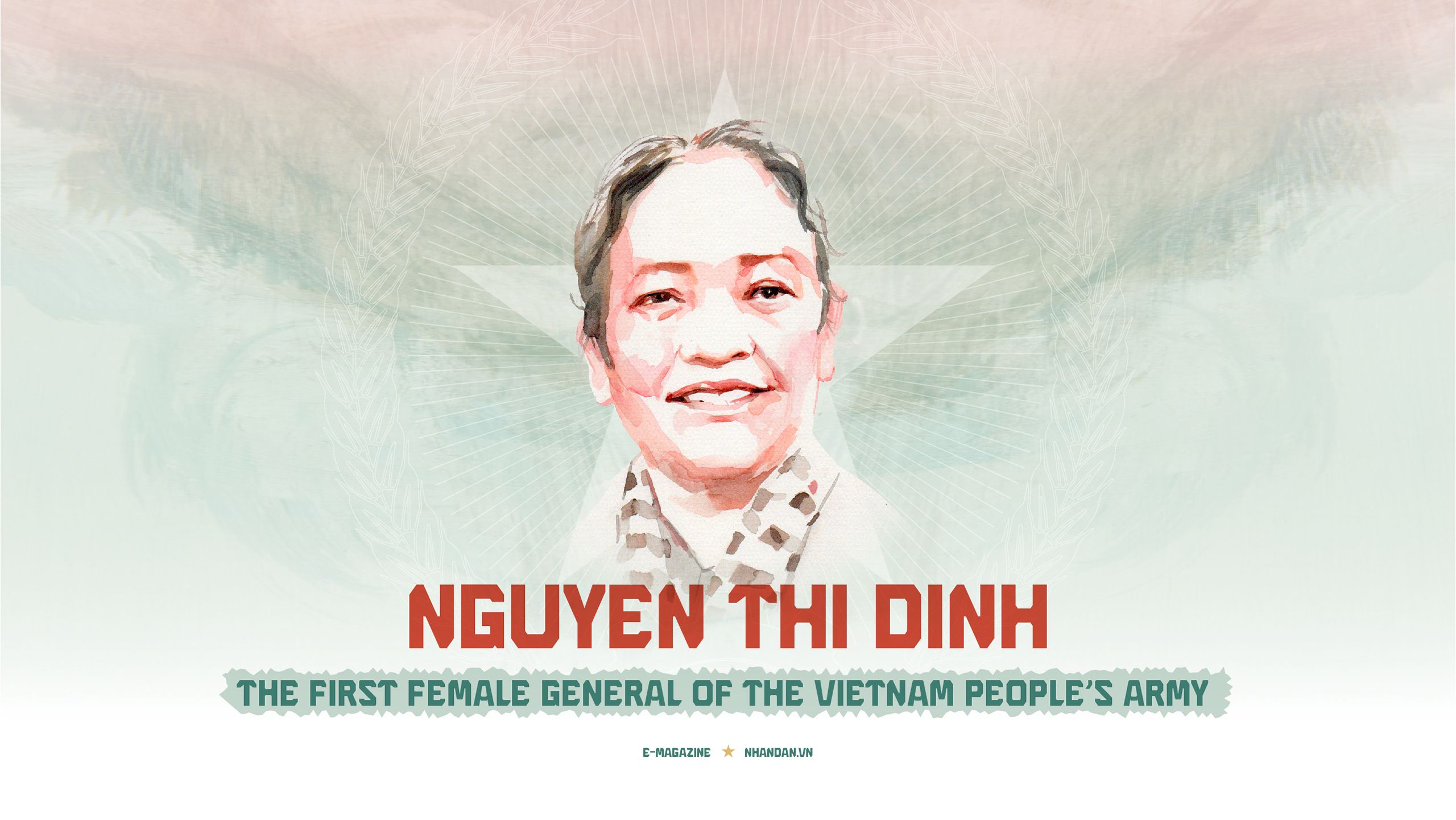
Biography of
Major General Nguyen Thi Dinh
Nguyen Thi Dinh was born on February 13, 1920, in Luong Hoa Commune, Giong Trom District, Ben Tre Province. At the age of 16, she became politically aware and joined the revolutionary movement, undertaking tasks such as communication, distributing leaflets, and mobilising the masses. In October 1938, she was admitted to the Indochinese Communist Party (now the Communist Party of Vietnam).
In 1940, her husband was captured and exiled to Con Dao, where he later perished. Six months later, Nguyen Thi Dinh herself was arrested and imprisoned at Ba Ra (now in Binh Phuoc Province). Due to severe heart disease, she was released in 1943 and placed under local surveillance. However, by 1944, she reconnected with the revolutionary organisation and resumed her activities. In August 1945, she participated in the uprising to seize power in Ben Tre. By March 1946, she was entrusted with leading a delegation of military, civilian, and political representatives to the North to report on the southern revolution and request arms to resist the French. In November of the same year, she successfully captained a boat carrying 12 tonnes of weapons back to the South, skilfully evading enemy patrols.
Her daring sea journey laid the groundwork for the establishment of the legendary Ho Chi Minh Trail at sea. In 1947, she was elected to the Ben Tre Provincial Party Committee and played a key role in organising the resistance movement.

After the Geneva Accords in 1954, she continued to lead efforts to protect revolutionary gains and resist the oppressive Ngo Dinh Diem regime. The Ngo Dinh Diem government searched for her fiercely, and even offered a reward for anyone who captured her.
However, she successfully evaded them by frequently changing her appearance, sometimes disguising herself as a monk, a trader, or a farmer, and receiving support from local revolutionary families and people. Under the leadership of Dinh and the local Party committee, the Dong Khoi movement in Ben Tre achieved victory on January 17, 1960, becoming a symbol of resilient resistance and a pivotal moment in the Southern revolutionary movement, marking a shift from a defensive situation to preserve forces, to an offensive position, leading to complete victory. Following the Dong Khoi Uprising, she served as the Secretary of the Provincial Party Committee and the President of the Liberation Front of Ben Tre Province.
In 1964, Dinh was elected as a member of the Central Committee of the National Liberation Front during its first congress. In 1965, she held the position of Deputy Commander of the National Liberation Front and became the President of the Union of Women for the Liberation of the South.
Throughout the anti-American resistance war, she and the Command of the Liberation Army of South Vietnam the Southern Command developed close bonds with the people, gaining numerous victories, contributing to the liberation of the South and the reunification of the country. In recognition of her contributions, she was promoted to Major General in April 1974, making her the first female general in the Vietnam People's Army.
After the reunification of Vietnam in 1975, she held several significant positions within the Party and State, including being a member of the Central Committee of the 4th, 5th, and 6th tenures, National Assembly deputy of the 6th, 7th, and 8th tenures, and President of the Vietnam Women’s Union. She served as Vice Chairwoman of the State Council from 1987 to 1992.
For her excellent services, Dinh was awarded many accolades, including Ho Chi Minh Order, first-class Feat-of-arm Order, first-class Military Exploit Order, first-class Order of Anti-US Resistance War and National Salvation, first-class Determination Order, 50-year Party membership badge, and Hero of the People's Armed Forces Title. She also gained recognition from foreign countries, including the first-class Freedom Order by the Lao People's Democratic Republic, the Lenin Peace Prize by the Soviet Union and was the first foreigner to be awarded the Soviet Union's Order of Friendship of Peoples; and the Order of Playa Girón by the Cuban Party and Government, among others.
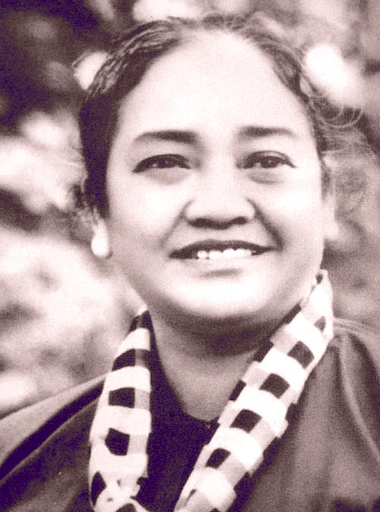

After the Geneva Accords in 1954, she continued to lead efforts to protect revolutionary gains and resist the oppressive Ngo Dinh Diem regime. The Ngo Dinh Diem government searched for her fiercely, and even offered a reward for anyone who captured her.
However, she successfully evaded them by frequently changing her appearance, sometimes disguising herself as a monk, a trader, or a farmer, and receiving support from local revolutionary families and people. Under the leadership of Dinh and the local Party committee, the Dong Khoi movement in Ben Tre achieved victory on January 17, 1960, becoming a symbol of resilient resistance and a pivotal moment in the Southern revolutionary movement, marking a shift from a defensive situation to preserve forces, to an offensive position, leading to complete victory. Following the Dong Khoi Uprising, she served as the Secretary of the Provincial Party Committee and the President of the Liberation Front of Ben Tre Province.
In 1964, Dinh was elected as a member of the Central Committee of the National Liberation Front during its first congress. In 1965, she held the position of Deputy Commander of the National Liberation Front and became the President of the Union of Women for the Liberation of the South.
Throughout the anti-American resistance war, she and the Command of the Liberation Army of South Vietnam the Southern Command developed close bonds with the people, gaining numerous victories, contributing to the liberation of the South and the reunification of the country. In recognition of her contributions, she was promoted to Major General in April 1974, making her the first female general in the Vietnam People's Army.
After the reunification of Vietnam in 1975, she held several significant positions within the Party and State, including being a member of the Central Committee of the 4th, 5th, and 6th tenures, National Assembly deputy of the 6th, 7th, and 8th tenures, and President of the Vietnam Women’s Union. She served as Vice Chairwoman of the State Council from 1987 to 1992.
For her excellent services, Dinh was awarded many accolades, including Ho Chi Minh Order, first-class Feat-of-arm Order, first-class Military Exploit Order, first-class Order of Anti-US Resistance War and National Salvation, first-class Determination Order, 50-year Party membership badge, and Hero of the People's Armed Forces Title. She also gained recognition from foreign countries, including the first-class Freedom Order by the Lao People's Democratic Republic, the Lenin Peace Prize by the Soviet Union and was the first foreigner to be awarded the Soviet Union's Order of Friendship of Peoples; and the Order of Playa Girón by the Cuban Party and Government, among others.
The outstanding feat of
female general Nguyen Thi Dinh
1. The soul of the Ben Tre Uprising
In January 1959, the 15th Plenum of the Party Central Committee agreed on and determined the basic line of the Southern revolution as an uprising to seize power for the people: using the strength of the masses, relying mainly on the political force of the masses, combining with the armed forces to overthrow the domination of imperialism and feudalism, and establishing a revolutionary government of the people. By the end of 1959, Resolution 15 of the Central Committee had reached the southern localities, igniting the flames of revolution in rural and urban areas.
In Ben Tre, to gain time and take advantage of the element of surprise, on January 1, 1960, Comrade Nguyen Thi Dinh organised an important meeting in Tan Hue Hamlet, Minh Duc Commune, Mo Cay District, to disseminate the spirit of Resolution 15 of the Central Committee and the policy of the Inter-Provincial Party Committee. After analysing and comparing us and the enemy, she emphatically stated: “Mobilise the masses, focus on mobilising soldiers’ families to rise up and destroy the system of suppression in the communes and hamlets, punish the informants — the villains — in the commune and hamlet militia, and the militia, and combine with the bases in the enemy’s heartland to force surrender, force withdrawal, take over the posts, and liberate the communes and hamlets.”
Then, on January 12, 1960, Nguyen Thi Dinh went to Binh Khanh Commune (Mo Cay District) to meet with Nguyen Tam Cang, the Provincial Party Committee member in charge of military and military affairs, to convey the spirit of Resolution 15 of the Central Committee and the uprising plan. She and her comrades resolved many important issues, including the content of affirming Resolution 15 of the Central Committee came to Ben Tre like a drought waiting for rain; unanimously choosing the three communes of Binh Khanh, Phuoc Hiep and Dinh Thuy in Mo Cay District, in the province’s base area, as the model.
As planned, on January 17, 1960, the people of Binh Khanh Commune and Dinh Thuy Commune rose up, then the Phuoc Hiep Commune party cell mobilised shock troops and the masses to arrest and disband hamlet militia, spies, informants and reactionary political organisations. On January 18, 1960, Phuoc Hiep was completely liberated. Thus, in just two days, the uprising was victorious in the three communes. Responding to the struggle movement of the people of the three communes of Dinh Thuy, Binh Khanh and Phuoc Hiep, on the night of January 17, 1960, the people of the communes in Mo Cay District rose up simultaneously. This was followed by the uprising of the people of other districts in Ben Tre.
In just one week (from January 17 to 25, 1960), the people of 47 communes in Ben Tre rose up to the pliers, level the posts, and smash the enemy’s repressive apparatus in the countryside, completely liberating 22 communes. More than 300 spies and villains were punished, destroyed, and forced to withdraw from 47 posts, confiscated 159 guns and many military equipment.
2. Commander of the “Long-haired Army” - a proud symbol of Vietnamese women
Immediately after the Dong Khoi uprising in Ben Tre broke out, the Saigon government mobilised many military forces to sweep into three communes of Dinh Thuy, Phuoc Hiep, and Binh Khanh in Mo Cay district. The sweep, called “Binh Tri Kien Hoa”, aimed to crush the mass revolutionary movement and destroy the liberation armed forces that were still in their infancy.
To deal with that plot, Nguyen Thi Dinh advocated gathering forces and organising a political struggle consisting of all women who went to Mo Cay district under the name of “reverse evacuation” (from the countryside to the city), avoiding the ongoing sweep operation but in reality denouncing the enemy’s crimes. The force participating in the fight was up to more than 5,000 people. Women and mothers, some carried the wounded, some carried corpses, and brought along bomb and bullet fragments as evidence. People flooded into the District Chief’s Palace, the information house, and public squares, crying and denouncing the enemy’s crimes, and demanding that the District Chief order treatment for the wounded, provide medicine and food for the people, and order a withdrawal so that people could return to work in peace. Witnessing that situation, many monks and intellectuals called for support for the “evacuation” of the people. Even the civil servants, soldiers and police of the Saigon government openly expressed their sympathy with the people. Under pressure from the masses, the District Chief of Mo Cay promised to immediately convey the people’s demands to the Governor of Ben Tre province and ordered assistance to the people to appease public opinion. On the 12th day of the struggle, the Saigon administration had to order the withdrawal of troops.
The victory of the first struggle in Ben Tre by the “Long-haired Army” was a vivid demonstration of the creativity of the political struggle combined with armed struggle and military agitation, which later became the strategic guiding principle for the Dong Khoi movement in the whole South.
Female General Nguyen Thi Dinh with the "Long-Haired Army"
Female General Nguyen Thi Dinh with the "Long-Haired Army"
The “Long-Haired Army” was not only one of the most effective grassroots forces protecting and supporting revolutionary bases and the armed forces in the south, but it also became an active fighting force directly confronting the enemy. The “Long-Haired Army” resolutely and continuously fought to break the "strategic hamlets", opposed rural pacification, countered sweeping military operations, and resisted the Saigon government's efforts to provide destructive artillery and forcibly recruit soldiers. With flexible and unpredictable combat methods, the "Long-Haired Army" was praised by military commentators for their ability to disable enemy aircraft, block artillery guns, stop tanks, and thwart enemy sweeps.
It is clear that the Dong Khoi (General Uprising) movement in Ben Tre Province initiated a wave of attacks and uprisings across the entire Southern region and marked the beginning of the "Long-Haired Army" — a unique force in the world which became a proud symbol of Vietnamese women in the struggle for national liberation.
Particularly noteworthy was the emergence of the talented leader, General Nguyen Thi Dinh. Her name has been etched in the glorious history of the Vietnamese nation, linked to the birth of the women's liberation movement throughout the south, and specifically among the women in the “land of coconut”. From the struggles by the "Long-Haired Army", the Dong Khoi Movement in Ben Tre in 1960 grew and played a vital role, contributing significantly to the victory of the Southern Revolution, culminating in the Great 1975 Spring Victory and the country’s reunification. This has further illuminated the patriotic, heroic, resilient, loyal, and industrious traditions of Vietnamese women, who are worthy descendants of the legendary heroines — the Trung Sisters.
Assessment of the first female General
The Vice Commander-in-Chief of the Southern Liberation Army is Nguyen Thi Dinh, and our country is the only one in the world to have such a female general. This is truly an honour for the south and for our entire nation.
Sister Ba Dinh was the one who directly took on the tasks from her superiors, directly guiding and organising the Dong Khoi Movement in Ben Tre. When I studied the details and systematically reviewed the famous Dong Khoi Movement, I was amazed by her organisational skills, her ability to mobilise forces, her competence in planning and executing strategies, and her leadership and response to situations... Clearly, through this movement, her tactical acumen, high determination, and leadership skills were highlighted. She was able to both form an organisation and conduct military operations on the complex battlefield, leading to a glorious victory.
“Comrade Nguyen Thi Dinh is one of the exemplary women of our country, an esteemed leader who was loved and respected by the people, soldiers and women across the country, as well as by friends around the world.”
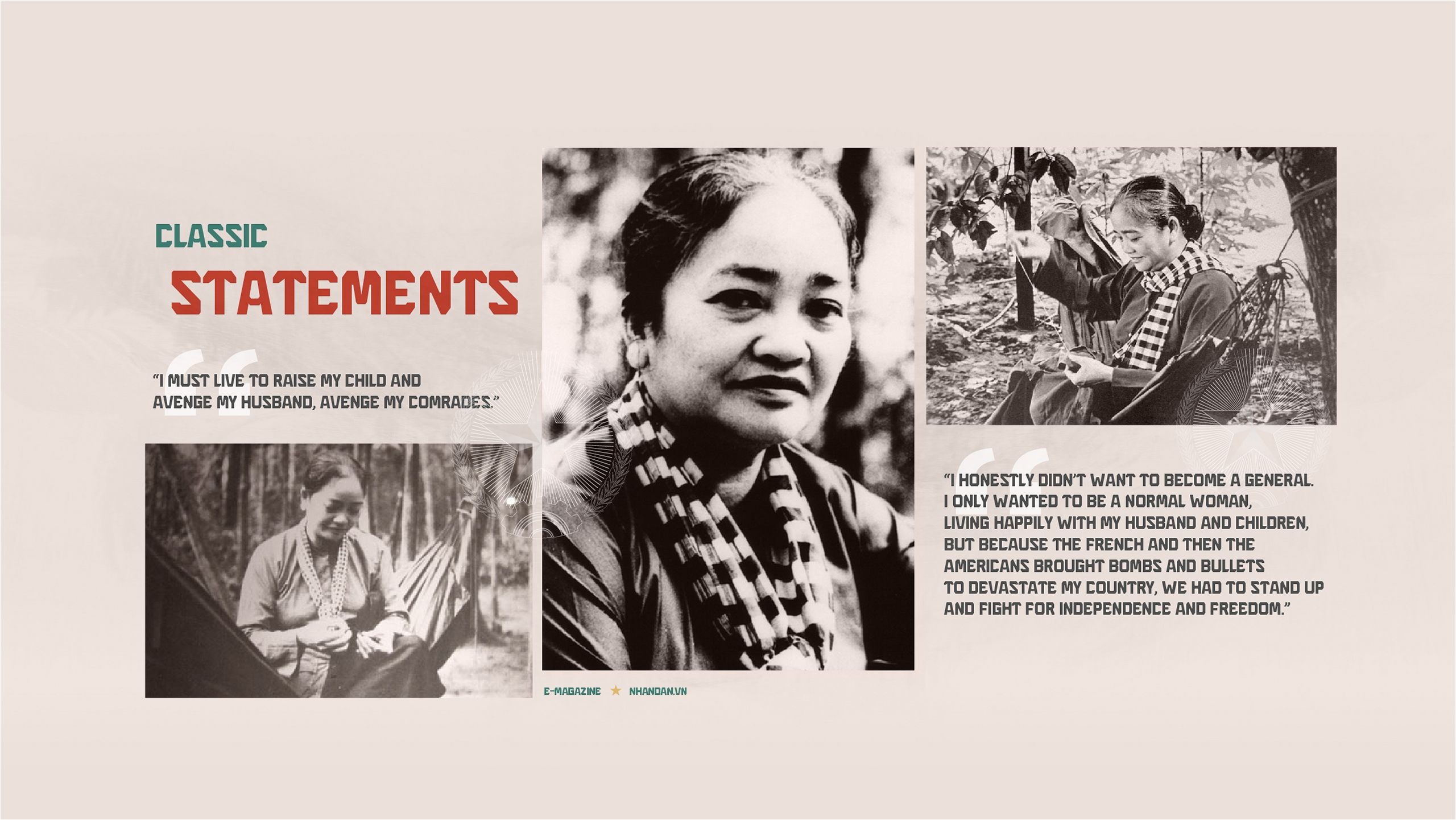
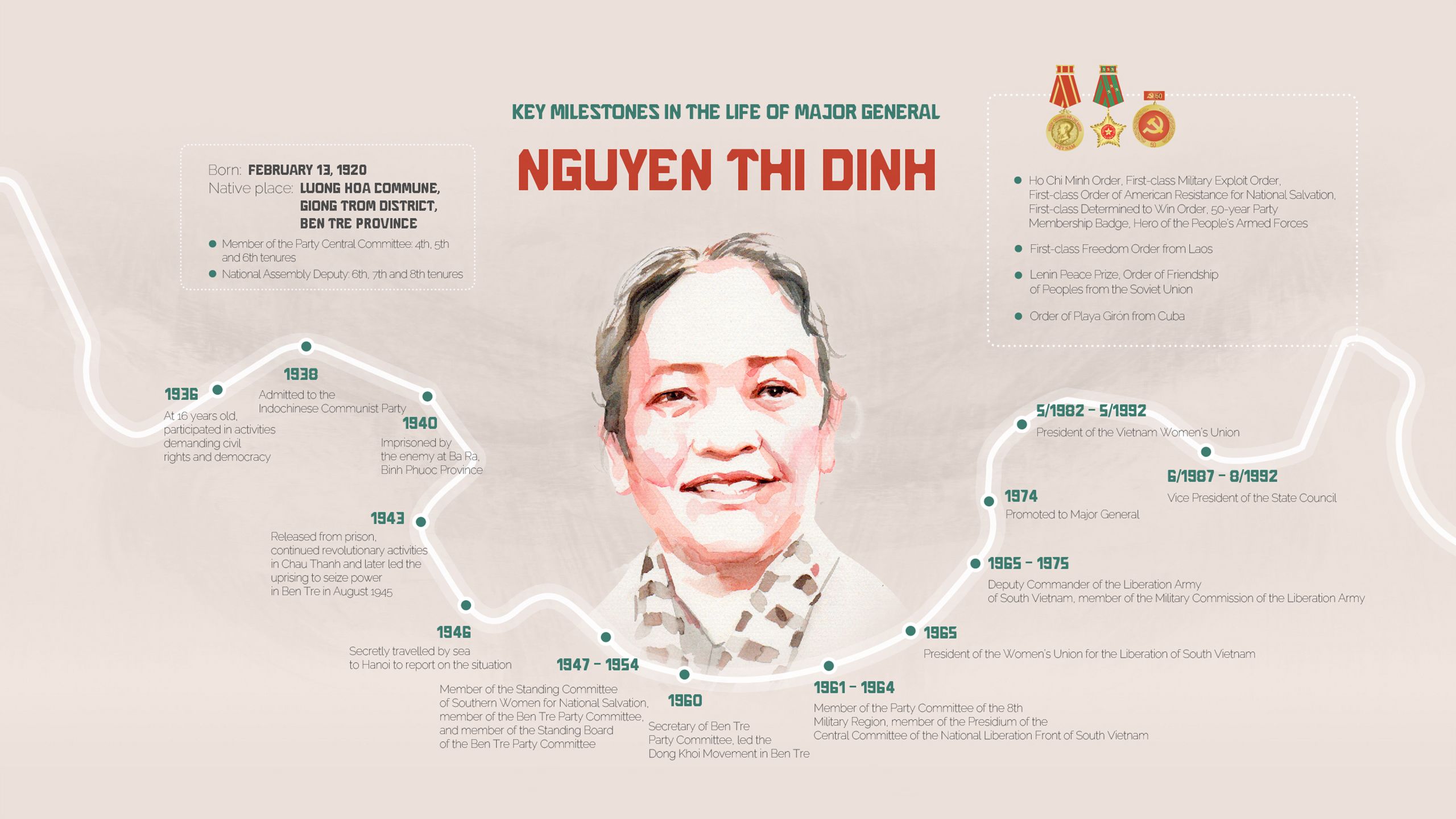
Published: December 2024
Content: Captain Nguyen Ngoc Toan, Institute of Military History
Photos: People’s Army, VNA, Ben Tre Museum
Portrait by Do Hoang Tuong
Design: Ta Lu



